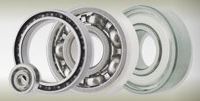The History of Precision Ball Bearings
Today we use precision ball bearings for a variety of different things. Precision ball bearings help make sure that there is a high degree of control and predictability of movement. Ball bearings are the most commons means by which such friction reduction is accomplished. But it was not always this way. There was a very simple start to the precision ball bearings that we see today. Yes, before miniature bearings, roller bearings, steel ball bearings, and thrust bearings there were simply bearings. Old wooden rollers that supported objects like how precision bearings do. Some historians would say that the invention of bearings may even possibly predate the invention of the wheel. The oldest history of bearings starts with the Egyptians and how they used roller bearings.

Image Courtesy of Dynaroll Corporation
It is under speculation that the Egyptians used these bearings in the form of tree trunks under sleds. The drawings that these people did are recorded in the tomb of Djehutihotep. The Twelfth Dynasty tomb of Djehutihotep has depictions of 172 men pulling an alabaster statue of him using the bearing system. This is the oldest possible recordings of bearings to date. There was a rolling bearing element that was discovered from Roman Nemi Ships in Lake Nemi, Italy that can be dated back to 40 AD but it was not discovered to be an actual ball bearing. The next recording of ball bearings evolving throughout history comes from world renowned thinker, Leonardo da Vinci. The first time he recorded this was in his personal drawings and design for a helicopter which was around the year 1500.

Image Courtesy of Dynaroll Corporation.
Fast forward 88 years, Agostino Ramelli is an Italian engineer who designs the book wheel or the reading wheel which becomes the first published engineer to have sketches of modern roller and thrust bearings. But Ramelli was not 100% correct in his efforts with some errors made in the process. However, Galileo would later on be the one to fix this model to almost perfection. The credited first practical cage-roller bearing goes to horologist John Harrison who used his invention for his H3 marine timekeeper. The first patent on ball bearings is awarded to Phillip Vaughan. He was a British inventor and ironmaster who used this tool for a ball bearing in Carmarthen which was dated in 1974.
The industrial revolution came after this which created a variety of different changes and patents throughout the evolution of precision ball bearings. The modern ball bearings that we use today can be linked back to every one of these subtle but extremely impactful changes. We see a variety of different applications some that include a rotating component. Other examples are some of the aerospace bearings that are used in the Mars Rover, gearboxes, wheel bearings on automobiles, and even in dental drills where ultra high speed bearings are used. It is truly amazing to look at how far we have come over time. If history repeats itself, which it very well could, there could be potentially even more conducive to our precision ball bearing needs.


 Castings & Forgings
Castings & Forgings Bulk Material Handling
Bulk Material Handling Electrical & Electronic Components
Electrical & Electronic Components Flow Instrumentation
Flow Instrumentation Hardware
Hardware Material Handling Equipment
Material Handling Equipment Metal Cutting Services
Metal Cutting Services Metal Forming Services
Metal Forming Services Metal Suppliers
Metal Suppliers Motion Control Products
Motion Control Products Plant & Facility Equipment
Plant & Facility Equipment Plant & Facility Supplies
Plant & Facility Supplies Plastic Molding Processes
Plastic Molding Processes Pumps & Valves
Pumps & Valves Recycling Equipment
Recycling Equipment Rubber Products & Services
Rubber Products & Services